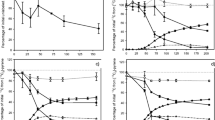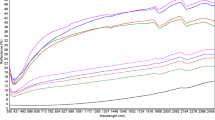Abstract
Experiments were carried out to evaluate the impact of the addition of ripe compost on the degradation of two 14C-labeled hydrocarbon model compounds (anthracene and hexadecane) in soil. The addition of mature compost (20 % dry wt./dry wt.) stimulated significantly the disappearance of the extractable fraction of both compounds. With compost, 23 % of the labeled anthracene was transformed into 14CO2 and 42 % was fixed to the soil matrix irreversibly. In the unsupplemented control reactor more than 88 % of the original anthracene could be recovered by either of two applied organic extraction procedures. The formation of non-extractable bound residues was less significant with [14C] hexadecane since only 21 % of the labeled carbon had become non-extractable after 103 days. The results presented show that compost could stimulate the depletion of hydrocarbons by either mineralization or the formation of unextractable bound residues (humification). The latter process might be a significant route of depletion in soil especially, for those hydrocarbons that are mineralized only slowly. The meaning of this finding for the assessment of soil bioremediation is discussed.
Similar content being viewed by others
References
Berghausen M, Goetz D (1993) Change of soil physical values through oil contaminations. In: Arendt F, Annokkee GJ, Bosman R, Brink WJ van den (eds) Contaminated soils '93. Kluwer, Doordrecht, pp 907–910
Berry DF, Boyd SA (1985) Decontamination of soil through enhanced formation of bound residues. Environ Sci Technol 19:1132–1133
Bollag JM (1992) Decontaminating soil with enzymes. Environ Sci Technol 26:1876–1881
Bollag JM, Loll MJ (1983) Incorporation of xenobiotics into soil humus. Experientia 9:1221–1231
Bollag JM, Myers CJ, Minard RD (1992) Biological and chemical interactions of pesticides with soil organic matter. The science of the total environment 123/124:205–217
Bumpus JA (1989) Biodegradation of polycyclic aromatic hydrocarbons by Phanerochaete chrysosporium. Appl Environ Microbiol 55:154–158
Calderbank A (1989) The occurrence and significance of bound pesticide residues. Rev Environ Contam Toxicol 108:71–103
Cerniglia CE, White GL, Heflich RH (1985) Fungal metabolism and detoxification of polycyclic aromatic hydrocarbons. Arch Microbiol 143:105–110
Dec J, Bollag JM (1988) Microbial release and degradation of catechol and chlorophenols bound to synthetic humic acid. Soil Sci Am J 52:1366–1371
Eschenbach A, Kästner M, Bierl R, Schaefer G, Mahro B (1994) Evaluation of a new and more effective method to extract polycyclic aromatic hydrocarbons from soil samples. Chemosphere 28:683–692
Franzius V, Stegmann R, Wolf K (1989) Handbuch der Altlastensanierung; RV Decker's Verlag G. Schenk, Heidelberg
Fritsche W Günther T, Hofrichter M, Sack U (1994) Metabolismus von polycyclischen aromatischen Kohlenwasserstoffen durch Pilze verschiedener ökologischer Gruppen. In: Sonder forschungs bereich 193 d. TU Berlin (ed) Schriftenreihe Biologische Abwasserreinigung, TU Berlin, Berlin, vol. 4: pp 167–182
Führ F (1987) Non-extractable pesticide residues in soil. In: Greenhalgh R, Poberts TR (eds) Pesticide science and biotechnology. Blackwell, Oxford, pp 381–389
Haider KM, Martin JP (1988) Mineralization of 14C-labeled humic acids and of humic-acid bound 14C-xenobiotics by Phanerochaete chrysosporium. Soil Biol Biochem 20:425–429
Hassett JJ, Banwart BL (1989) The sorption of nonpolar organics by soils and sediments. In: Sawhney BL, Brown K (eds) Reactions and movement of organic chemicals in soils, SSSA and ASA, Madison, Wis, pp 31–44
Heitkamp MA, Freeman JP, Miller DW, Cerniglia CE (1988) Pyrene degradation by a Mycobacterium sp.: identification of ring oxidation and ring fission products. Appl Environ Microbiol 54:2556–2565
Hsu TS, Bartha RJ (1976) Hydrolysable and nonhydrolysable 3,4-dichloroaniline humus complexes and their respective rate of biodegradation. J Agric Food Chem 24:118–122
Jandel AS (1991) Ölunfälle schnell beheben. Umwelt 21:358–359
Jenkinson DS, Powlson DS (1976) The effects of biocidal treatments on metabolism in soil. V. A method for measuring soil biomass. Soil Biol Biochem 8:209–213
Kästner M, Schaefer G, Breuer-Jammali M, Mahro B (1992) Comparison of the microbial degradation potential for PAH in liquid medium, soil and soil compost. In: Kreysa G, Driesel AJ (eds) Dechema Biotechnol Conf 5:1043–1046
Kästner M, Breuer-Jammali M, Mahro B (1994) Enumeration and charaterization of the soil microflora from hydrocarbon-cantaminated soil sites able to mineralize polycyclic aromatic hydrocarbons. Appl Microbiol Biotechnol 41:267–273
Lotter S, Heerenklage J, Stegmann R (1992) Carbon balance and modelling of the oil degradation in soil bioreactors. In: Klein J (ed) Preprints International Symposium: Soil decontamination using biological processes. Dechema, Frankfurt, pp 219–227
Lotter S, Brumm A, Bundt J, Heerenklage J, Paschke A, Steinhart H, Stegmann R (1993) Carbon balance of a PAH-contaminated soil during biodegradation as a result of the addition of compost. In: Arendt F, Annokkee GJ, Bosman R, Brink WJ van den (eds) Contaminated soils '93. Kluwer Doordrecht, pp 1235–1245
Mahro B, Kästner M (1993) Der mikrobielle Abbau polyzyklischer aromatischer Kohlenwasserstoffe (PAK) in Böden und Sedimentten: Mineralisierung, Metabolitenbildung und Entstehung gebundener Rückstände. Bioengineering 9:50–58
Means JC, Wood SG, Hassett JJ, Banwart WL (1980) Sorption of polynuclear hydrocarbons by sediments and soils. Environ Sci Technol 14:1524–1528
Michaelsen M, Hulsch R, Höppner T, Berthe-Corti L (1992) Hexadecane mineralization in oxygen-controlled sediment seawater cultivations with autochthonous microorganisms. Appl Environ Microbiol 58:3072–3077
Püttmann W (1988) Kriterien zur Beurteilung von Sanierungsverfahren auf mikrobiologischer Basis. In: Rosenkranz D, Einsele G, Harreβ HM (eds) Bodenschutz. Erich Schmidt, Berlin, Lfg V/90: 1–25
Richnow HH, Seifert R, Hefter J, Kästner M, Mahro B, Michaelis W (1994) Metabolites of xenobiotica and mineral oil constituents linked to macromolecular organic matter in polluted environments. Org Geochem 22:671–681
Schnöder F, Mittelstaedt W, Führ F (1994) Das Verhalten von Benzo (a) pyren in einer Parabraunerder-Lysimeter-und Laborabbaustudienn. In: TU Berlin (ed) Schriftenreihe Biologische Abwasserreinigung, vol 4. pp 217–230
Senesi N (1992) Binding mechanisms of pesticides to soil humic substances. The science of the total environment 123/124:63–76
Shannon MJR, Bartha R (1988) Immobilization of leachable toxic soil pollutants by using oxidative enzymes. Appl Environ Microbiol 54:1719–1723
Stegmann R, Lotter S, Heerenklage J (1991) Biological treatment of oil-contaminated soils in bioreactors. In: Hinchee RE, Olfenbuttel RF (eds) On site bioreclamation: processes for xeniobiotic and hydrocarbon treatment. Butterworth-Heinemann, Boston, pp 188–208
Sutherland JB, Freeman JP, Selby AL, Fu PP, Miller DW, Cerniglia CE (1990) Stereoselective formation of a K-region dihydrodiol from phenanthrene by Streptomyces flavovirens. Arch Microbiol 154:260–266
Weiβenfels WD, Beyer M, Klein J, Rehm HJ (1991) Microbial metabolism of fluoranthene: isolation and identification of ring fission products. Appl Microbiol Biotechnol 34:528–535
Weiβenfels WD, Klewer HJ, Langhoff J (1992) Adsorption of polycyclic aromatic hydrocarbons (PAHs) by soil particles: influence on biodegradability and biotoxicity. Appl Microbiol Biotechnol 36:689–696
Wislocki PG, Lu AYH (1988) Carcinogenity and mutagenity of proximate and ultimate carcinogens of polycyclic aromatic hydrocarbons. In: Yang SK, Silverman BD (eds) Polycyclic aromatic hydrocarbon carcinogenesis: structure activity relationships, vol 1 CRC, Boca Raton, Fla, pp 1–30
Yang SK, Silverman BD (1988) Polycyclic aromatic hydrocarbon carcinogenesis: structure activity relationships. CRC, Boca Raton, Fla, vol. 1 and 2
Author information
Authors and Affiliations
Additional information
These authors contributed equally to the presented work and should therefore both be considered as first authors
Rights and permissions
About this article
Cite this article
Kästner, M., Lotter, S., Heerenklage, J. et al. Fate of 14C-labeled anthracene and hexadecane in compost-manured soil. Appl Microbiol Biotechnol 43, 1128–1135 (1995). https://doi.org/10.1007/BF00166937
Received:
Revised:
Accepted:
Issue Date:
DOI: https://doi.org/10.1007/BF00166937




